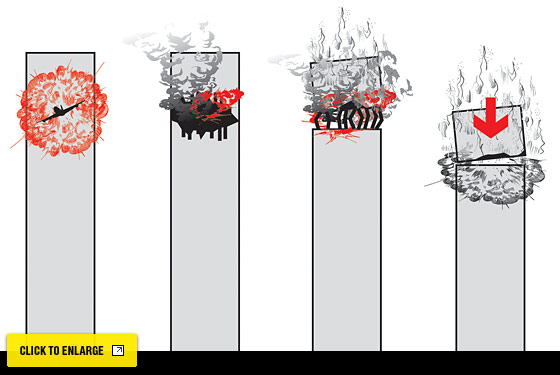T3: Anatomy of a Fall
From the moment when video of the Towers’ collapse appeared, conspiracy theorists began to speculate that the buildings had been brought down by explosives. Using as evidence the puffs of dust and debris that shot out of the buildings’ sides and the speed at which the structures fell, truthers saw a secret government demolition plot (see also “Building 7”).
The Towers failed, however, not because of C-4 or any other explosive but because of “total progressive collapse,” an engineering phenomenon first identified in the late sixties after the partial destruction of a 22-story apartment complex in East London. A gas explosion on the eighteenth floor damaged a load-bearing support, causing the top four floors to fall, crushing the ones beneath.
In total progressive collapse, a structure incurs extreme localized damage, and significant elements of the building are weakened. If the damage is not contained, structures elsewhere in the building give way and cause a catastrophic failure. In the case of the North and South Towers [T3], the buildings’ design called for the core columns, through a series of steel floor trusses and concrete blocks, to support the load of the floors. On September 11, the impact of the aircraft blasted off the spray-on fireproofing that had been applied to the buildings’ core columns; 128,000 pounds of burning, loose fuel began superheating them to temperatures up to 1,500 degrees Fahrenheit. Although the steel didn’t melt, it greatly softened, and buckled; as the floors began to sag, the exterior columns were pulled inward. The combination of gravity and the downward kinetic force of the higher floors caused the floors below to successively collapse (causing the puffs of dust and debris) until they hit the ground. The top floors then collapsed on top of the already-reduced-to-rubble pile, causing further wreckage.
Seismograph readings taken by Columbia University indicate two events registering 2.1 and 2.3 on the Richter scale—one for each building’s collapse. The spikes started small and then grew as the buildings toppled, evidence that contradicts claims of an explosion: If the Towers’ collapse had been a controlled demolition, the spikes would have been sharper and more sudden.

